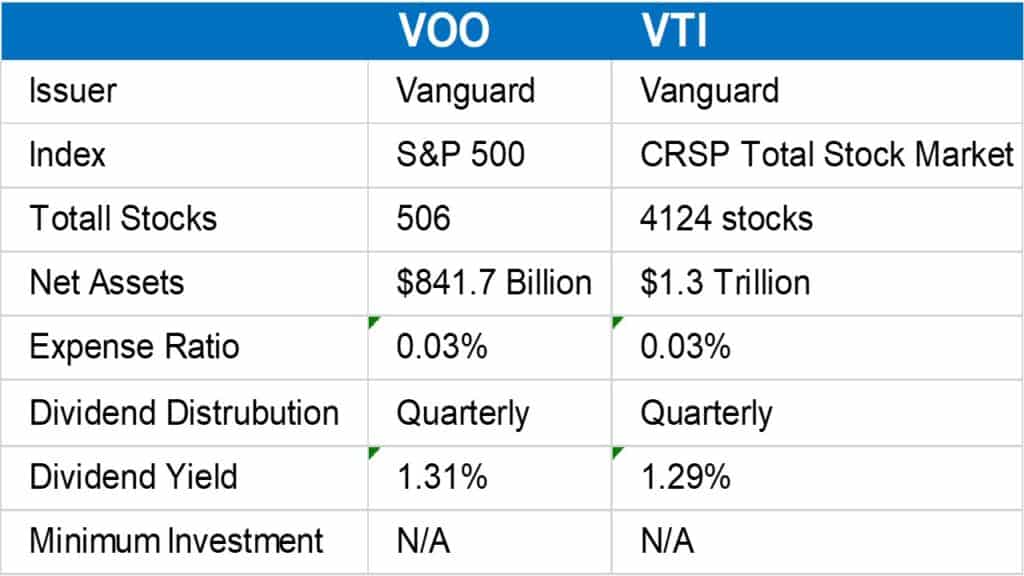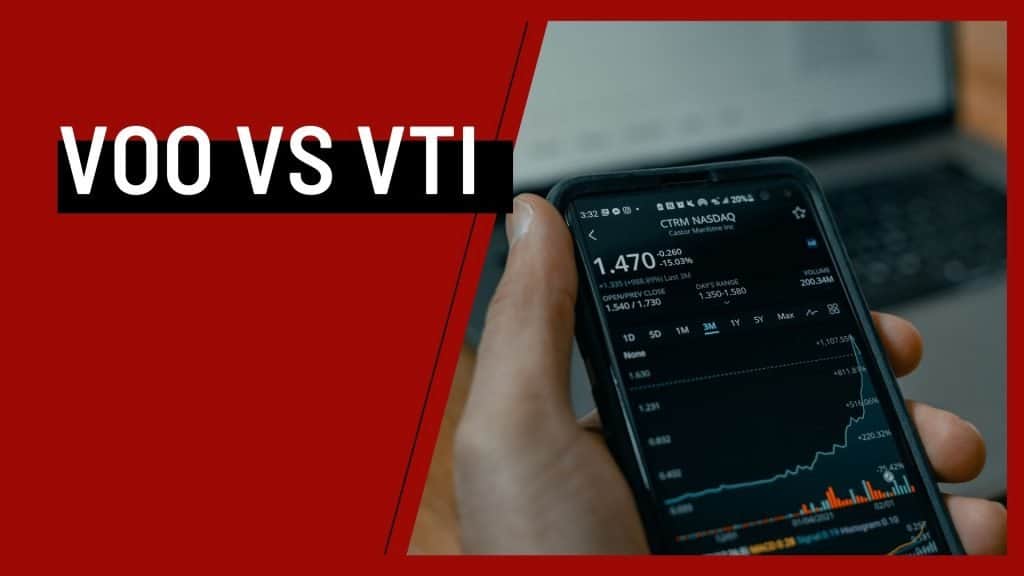Thinking about investing comes with many thoughts about what to choose. It would be simply better for most people to choose an excellent simple index fund. Two of the best index funds out there is VTSAX and VFIAX.
Vanguard has made these index funds into exchange-traded funds, or ETFs for short. There is competition over choosing the S&P 500 Index ETF or a Total Stock Market Index ETF.
What is the best ETF index fund? VOO vs VTI are two of the top ETFs many people talk about. The great debate has started since these two funds started.
VFIAX, the Vanguard S&P 500 index fund, is made into an ETF in VOO, and then you have the VTSAX, the total market index fund that tracks the whole market created into VTI. With all the hype about both of them, which one would you choose? VOO vs VTI.
What is an Index Fund?
Before we figure out which one to choose, let's break down what an index fund is. Back in the day, 1976, John Bogle wanted to help the average Joe invest.
There were multiple ways to invest already. Actively managed mutual funds were the best choice for most people. These mutual funds had high expense ratios and fees charged by the financial institutions.
Bogle came up with a low-cost alternative called an index fund. Index investing is all about having a fund mirror a specific index and not trying to outperform the market. The passive way of investing allows investors to have low fees and create wealth simultaneously. It is a much simpler way to invest for the long haul.
The major indexes that we have today would be the S&P 500, the Dow Jones, and the Nasdaq 100, which tracks the top 100 tech companies.
The cool thing about these index funds is that it allows ordinary people to invest and match the returns of the market. On average, the S&P 500 has grown by 10% over the last 100 years and now has an index fund.
Instead of investing in a mutual fund that claims it could beat the market plus charge you higher fees, you could be investing in a low-cost index fund.
The majority of investors should be using low-cost index funds. It is the simple path to wealth.
VTI: Vanguard Total Stock Market Index Fund:
VTI is the Vanguard Total Market Index Fund ETF with the same funds and portfolio as VTSAX. The only two differences between VTI and VTSAX are that one is an ETF with a lower expense ratio, and one is classified as a mutual fund.
It is comprised of over 4100 stocks. It gives you a piece of every company on the stock market. Diversity alone can help a portfolio take on many ups and downs with the market.
The expense ratio of VTI is 0.03%, costing the investor $3 for every $10,000, which makes it one of the best low-cost options out there.
The Top 10 Holdings for VTI:
- Apple
- Microsoft
- Alphabet Inc. Class A
- Amazon
- Tesla
- Nvidia
- Berkshire Hathaway
- Meta
- UnitedHealth Group Inc.
- Johnson & Johnson
These top 10 holdings make up 25.6% of VTI. Technology makes up about 27% of the portfolio when looking at the entire portfolio. The CRSP Total Market index that VTI follows is a market-weighted index giving the large-cap companies more dominance over the fund.
VOO: The Vanguard S&P 500 Index Fund ETF
VOO is a bit different than VTI. VOO is the Vanguard S&P 500 Index Fund ETF made out of the same allocation as VFIAX. The difference between the two is the lower expense ratio and being an ETF instead of a mutual fund.
You cannot go wrong with this ETF. It is made of large-cap companies with over 500 stocks that they are invested. Those are the top 500 companies on the U.S. stock market. It is an excellent ETF giving exposure to the best companies in the U.S., such as Apple, Amazon, Tesla, and Coke Cola.
The Top 10 Holdings:
As you can tell, the top 10 holdings look exactly like the top 10 holdings of VTI. Since VOO has fewer stocks invested, these ten companies represent a higher percentage of the portfolio than VTI. These top ten holdings represent 30% of the portfolio. Here they are:
- Apple
- Microsoft
- Alphabet Inc. Class A
- Amazon
- Tesla
- Nvidia
- Berkshire Hathaway
- Meta
- UnitedHealth Group Inc.
- Johnson & Johnson
With a large percentage of the portfolio represented by these top 10, the diversification is much less, and if one of the stocks goes down in value, it can take the fund down with much less effort.
Let's Break down VOO and VTI:

As you can tell, the yields of both funds are pretty similar and not much of a difference. The most significant difference between these two funds is the number of stocks they hold in their fund.
VOO is with 500 different companies, and VTI has around 4100 other companies. If you were looking for diversification, this is almost a no-brainer looking at these numbers, but let's dive into these numbers.
The Investor Influence:
Many investors will say one of these two funds is their go-to investment. Warren Buffet, one of the greatest investors of all time, said
“Consistently buy an S&P 500 low-cost index fund… I think it's the thing that makes the most sense practically all of the time.”
If he dies, Warren Buffett suggested putting 10% of his money into government bonds and 90% of the money into a low-cost index fund invested in the S&P 500. This would be the allocation he would want for his wife.
If Warren Buffet believes this highly in a fund like VOO, then we should all take a listen.
There is also what J.L. Collins thinks as well. J.L. Collins is famous for writing The Simple Path to Wealth. He is blunt, to the point, and says owning a fund like VTI gives you international diversification, and you have a piece of every company in the U.S.
VOO vs VTI in Similarities:
These two funds are pretty similar in how they operate. They have low costs and excellent tax efficiency, and they are a significant fund to add to your portfolio.
VOO vs VTI: Low-Costs
I talked about index funds having low costs. Both VOO and VTI have an expense ratio of 0.03%. On a $10,000 investment, you will be paying $3.
That is so minimal in the grand scheme of things.
ETFs ( Exchange-traded Funds) like ARKK, by Cathie Wood, have an expense ratio of 0.75%. That is $75 for every $10,000.
That can add up. A $1,000,000 investment into ARKK will cost you $7500 every year. With VOO or VTI, the price will be $300.
Just with the cost alone, you have to make a choice. Will the returns be good enough to justify paying an extra $7200?
The Fund Minimums to Invest
It is pretty simple, whatever the ETF price is, how much you can invest. Both VOO and VTI have a minimum to invest. If VOO is trading at around $400 a share, you can easily buy it at $400. If VTI is trading at $215 a share, you can purchase multiple shares.
ETFs and mutual funds are different in this respect. ETFs are traded like stocks. So as the price fluctuates throughout the day, you will pay the cost when you buy it, or you can set limit prices.
A mutual fund is traded at the end of the day. VTSAX and VFIAX, the index funds that have been created into VOO and VTI, are both traded at the end of the day. They have a minimum investment of $3,000 to enter the fund, and after that, you can put in as much or little as you choose.
Since ETFs were created, many brokerage companies have developed ways to buy fractional shares. M1 Finance and Robinhood have started this trend, and now Fidelity has begun buying and selling fractional shares. It has become much easier for the investor to get into these funds by investing with little money.
VOO vs VTI: The Differences:
With these two ETFs come many differences. They are not identical, but they are great investments for many people. Here are a couple of differences.
Fund Composition
It has been mentioned before that VOO tracks the S&P 500, and VTI represents the CRSP U.S. total stock market fund. Not all indexes are the same, but since the CRSP holds similar rankings for the large-cap stocks, these two indexes are very similar.
The total market stock index fund is an excellent way to have some diversification in other small-cap stocks. Not all total stock market index funds are the same. A prime example is FSKAX and VTSAX, which are total stock market index funds but do not track the same index.
The composition of the funds does matter when you are looking at performance, market caps, and diversification.
VOO vs VTI: Diversification is Key
Diversification is everything. If you have one or two stocks and one goes belly up, you are left with half of your investment. With VOO having fewer stocks invested, the potential of volatility is a bit more than VTI.
VOO has about 500 companies, which gives it a pretty good level of diversification. That diversification concentrates on large blend companies. They have to meet specific criteria for the S&P 500 to include them. Tesla made it into the S&P 500 in December of 2020.
VTI has about 4100 companies in it, giving it more diversification. Having a piece of every company on the U.S. stock market allows the investor to invest in companies that have not yet made it into the S&P 500. Google and Tesla are prime examples of this rule. Before they got admitted, you could own them through VTI. So you were able to capture their rise much earlier in time.
As other companies come up, there will be companies that fail. You would have some significant diversification by picking one of these funds, but having more stocks allows the index fund to be more self-cleansing. Then you will not have as much volatility through the fall and rise of the market.
Performance of VOO vs VTI:
As we take a look at the performance of these two funds over the last couple of years, you will see that their performance is very similar in that respect.
VOO performance:
- 1 year: 15.67%
- 3 year: 18.93%
- 5 year: 15.98%
- 10 years: 14.61%
VTI performance:
- 1 year: 11.71%
- 3 year: 18.18%
- 5 year: 15.39%
- 10 years: 14.25%
As you can see, they have relatively similar performance over the long term. You cannot go wrong with either one of these funds. Over the last ten years, VOO has done a better job overall. It all depends on the market.
With the tech boom, the tech industry has lifted the funds that track the S&P 500, making a massive difference in performance.
Advantages and Disadvantages of Owning VOO vs VTI
There are many advantages and disadvantages to owning both VOO and VTI; here is a little breakdown of what you will get if you invest in either of these funds.
Pros of VOO:
- It tracks the S&P 500 Index, which is averaging a 10% annual return a year
- There is a higher yield for dividends
- There is a greater concentration of larger companies.
- The performance over the last ten years has outperformed VTI slightly.
Cons of VOO:
- There are only 500 companies, which is minor in diversification
- There is a criterion to get into the S&P 500.
- Up and coming companies may not get into it yet.
Pros of VTI:
- Includes all publicly traded companies
- Includes up-and-coming companies like when Tesla was coming up or even Google.
- Broader exposure to mid and small-cap stocks.
- Dividend growth has a more extended history
- The performance over the last five years has outpaced the S&P 500.
Cons of VTI:
- 3000 of the stocks is a tiny percentage
- Lower dividend yield
Which one should you choose?
It is always a good question when looking at different index funds and seeing which one is better. Warren Buffett believes in the S&P 500 because it holds the top 500 companies in the U.S. stock market.
I personally like VTI. It gives a good amount of diversification. When an up-and-coming company moves up in the stock market, you will already own it.
If you just had VOO instead of VTI, you may miss out on the rise of a company until it can make it into the S&P 500.
It is up to you. You cannot go wrong with either one. Have fun, and keep investing. Suppose you want to take a look at two other funds. My other two favorite ones would be VTSAX vs FZROX. Take a look at these two and see what you think.
Related Posts:
- VTSAX vs VFIAX: Which One Would You Choose?
- VTSAX vs FZROX: Who is The Best?
- VTI vs VTSAX: How Are They Different?
- SPY vs VOO: Which S&P 500 ETF is The Better Buy

I’m Steve. I’m an English Teacher, traveler, and an avid outdoorsman. If you’d like to comment, ask a question, or simply say hi, leave me a message here, on Twitter (@thefrugalexpat1). Many of my posts have been written to help those in their journey to financial independence. I am on my journey, and as I learn more I hope to share more. And as always, thanks for reading The Frugal Expat.








I had no idea that Warren Buffett liked VOO. I’m so happy to find out today and I invested in the same index fund that Warren Buffett likes 🙂
I’m also glad that there isn’t a whole lot of difference long term between VOO and VTI. It means both are good picks!! Maybe I should consider investing in both.. hmm..
Buffett has talked about having all of the money given to his wife to be put in a Vanguard index fund that tracks the S&P 500 when he dies. That is VOO. If Warren Buffett says to do it, we should listen.
They are both pretty good picks indeed. As history as shown, the performance is pretty similar. I think that has to do with the S&P 500 companies being a huge proportion in VTI as well. You cannot go wrong with picking either of them.
I chose VTI for diversification reason, and also because it’s cheaper…lol. But that doesn’t mean I don’t believe in VOO, I do have a few parts in it.
I believe it’s like doing anything, consistency is the key. If you stick to a routine and practice it consistently for years, you are going to see the result. However, if you keep switching up your routines hoping to reap the short-term gains here and there, you might see some beginner gains but that’s it.
Thank you for sharing great tips again. Finally, here’s one more thing I like about index fund is that it’s never to late to get in!
Tommy,
You are correct. Sticking to one strategy is a good strategy. Obviously, if yours is failing you can alter it, but as you mention you are doing pretty well with sticking with funds like VTI or VOO. Diversification is key. Having more can really help stabilize downturns and capture huge gains as well.
You are right again. It is never too late to start. With VTI at $217, you can start with a couple and really gain momentum towards some future gains.
Love your blog Steve! I’m a big fan of both VTI and VOO, as I believe they are the 2 best index funds. The top 10 holdings really make the difference and since they are the same for VTI and VOO, I would also recommend both. I really appreciated your bar chart comparing the expense ratios with ARK and mutual funds. I personally am invested in mostly VTI because it has outperformed VOO as you’ve shown. In addition, VTI captures more of the total market itself. Keep up the great work!!
Thank you for your kinds words. I love some VTI myself. As you mention, the top 10 holdings with VOO and VTI are the same, and you cannot go wrong picking either one of them.
I wanted to use the chart to show the differences fees can really have on a fund. As ARKK is a popular ETF, the fee is much more than you would find with a low-cost index fund. If the fund goes down, the fees will start to eat up at the returns.
Thank you for reading.
i would split 50/50 in VOO and VTI